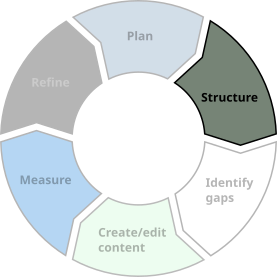Information architecture
Like a house, content needs architecture and structure. I can guide you toward effective information architecture.

The way you present and organize your content says a lot to your clients and customers. Giving structure to your organization’s content ensures:
- Your reputation is bolstered by high-quality content.
- Consistency across every piece of content and channel.
- Programmatic ingestion and manipulation.
- Effective SEO.
- A consistent experience to your users and staff.
- People quickly get the answers they need to move on with their day.
Examples
- Re-architected a 1200-topic, 10-year-old Adobe RoboHelp HTML system based almost exclusively on FAQs. Using a data-driven approach, I reduced topics by 50% and increased traffic to the remaining topics.
- Developed and implemented a unique publishing workflow leveraging DITA XML and XSLT to use Confluence as a Content Management System (CMS).
Tools used
Excel
Microsoft
Kibana
Elasticsearch
Miro mockup and diagramming tool
Miro
SEO Spider
Screaming Frog